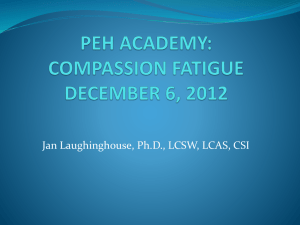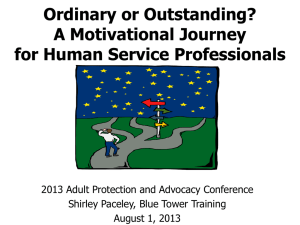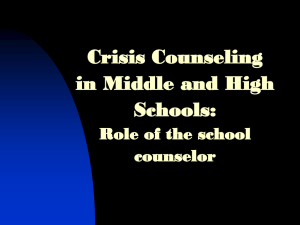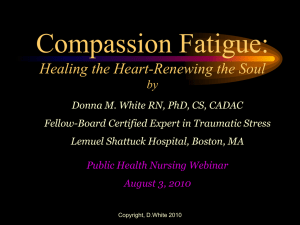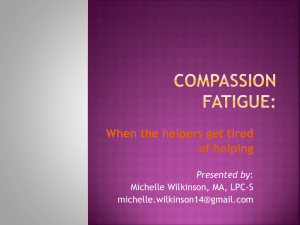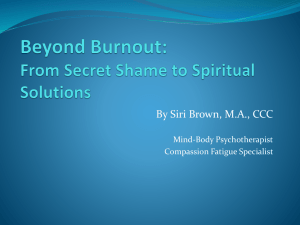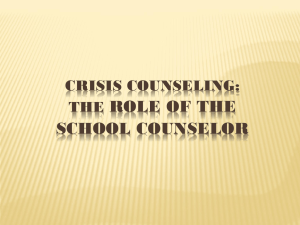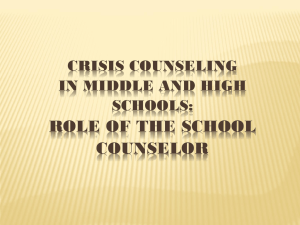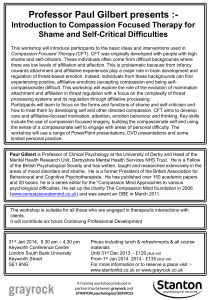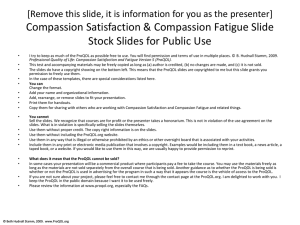Compassion Fatigue - PA Behavioral Health and Aging Coalition
advertisement
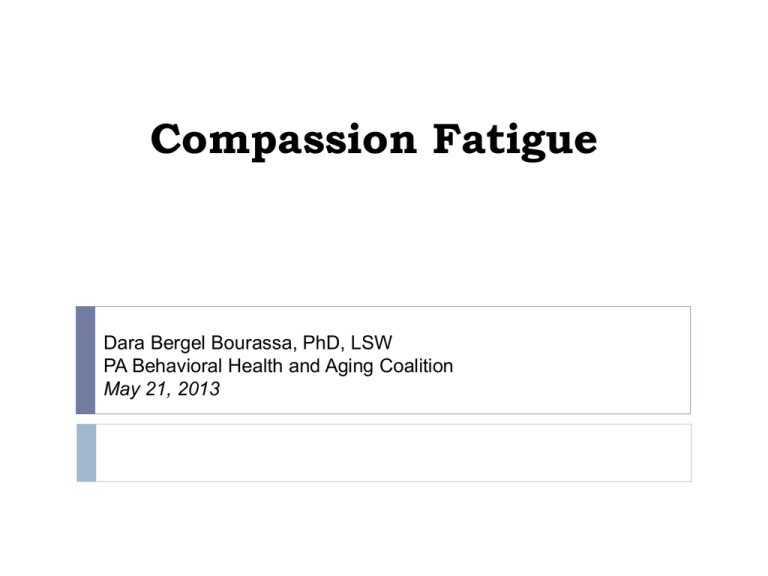
Compassion Fatigue Dara Bergel Bourassa, PhD, LSW PA Behavioral Health and Aging Coalition May 21, 2013 Is this Compassion Fatigue? http://muttscomics.com/art/dailyarchive.asp June 4, 2007 The Patriot-News What is Compassion Fatigue? Relatively new concept Also known as Secondary Traumatic Stress Disorder Many professions susceptible Natural behaviors and emotions resulting from learning about a client’s traumatizing event (Figley, 1995) The resulting stress from helping a traumatized person Traumatizing Events: Rape, neglect, abuse, domestic violence, sexual, verbal, financial abuse, natural or man-made disasters Compassion Satisfaction Risk Factors for Compassion Fatigue Symptoms and Effects of Compassion Fatigue 27% of professionals who work with traumatized victims experience extreme distress (Meldrum, King, & Spooner, 2002) Symptoms http://www.giftfromwithin.org/html/CFChart.htm Ethical issues May encounter disturbances in degree of empathy Ultimately jeopardizing clients Other ethical issues Effects of Compassion Fatigue cont. Problems with coping skills Decrease in sense of accomplishment Loss of confidence when working with clientele Damaged spirituality More likely to engage in avoidance of client and self May weaken and destroy one’s faith Personal problems Within personal and professional life Emotionally withdrawn from friends, family, colleagues, & clients Vicarious Traumatization vs. Compassion Fatigue Vicarious traumatization (McCann & Compassion Fatigue Pearlman, 1999; Jenkins & Baird, 2002) Psychotherapy with sexual assault victims Accumulation over long periods of time and across many clients Involves permanent changes in the cognitive processing of the therapist Based in Constructivist SelfDevelopment Theory (Figley, 1995; Bell, 2003) All professions are susceptible One acute exposure to traumatic material Can be treated if caught early Focuses on PTSD symptomatology Burnout vs. Compassion Fatigue Burnout (Maslach, 1982) Linked to stressors in the occupational environment Emerges gradually over time Easily identified Can affect any profession regardless of client group Is about being “worn out” (Stamm, 2009-2012) Compassion Fatigue (Figley, 1995) Results from listening to clients’ traumatic stories Can emerge suddenly and without warning May not be easily identified Only affects those who work with traumatized victims Is about being “afraid” (Stamm, 2009-2012) Ways to Protect Against CF… General Self-Care Develop a “buddy system” among group members to provide constant support (Myers & Wee, 2002) Increasing exercise/activity levels and taking time for yourself (Dutton & Rubenstein, 1995; Myers, 1994) Meditation/yoga (Politsky, 2007) Importance of positive self-talk and self-encouragement (Myers, 1994) Appropriate use of humor (Moran, 2002) Refer to individual counseling if more services are needed Self-assessment tool for Compassion Fatigue Professional Quality of Life Scale (PROQOL),Version 5 http://www.proqol.org/uploads/ProQOL_5_English_SelfScore_3-2012.pdf Created by B. Hudnall Stamm. Version 5 is copyrighted from 2009-2012. The ProQOL is free to use! A 30 item self report measure of the positive and negative aspects of caring (CF and compassion satisfaction) It is also published in many other languages Check out this web page http://www.proqol.org/ProQol_Test.html for additional languages Any Questions??? Contact Information: Dara Bergel Bourassa, PhD, LSW dpbourassa@ship.edu 717-477-1969 References Bell, H., Kulkarni, S., & Dalton, L. (2003). Organizational prevention of vicarious trauma. Families in Society, 84(4), 463-470. Cunningham, M. (1999). The impact of sexual abuse treatment on the social work clinician. Child and Adolescent Social Work Journal, 16(4), 277-290. Cunningham, M. (2003). Impact of trauma work on social work clinicians: Empirical findings. Social Work, 48(4), 451-459. Dane, B. & Chachkes, E. (2001). The cost of caring for patients with an illness: Contagion to the social worker. Social Work in Health Care, 33(2), 31-51. Figley, C.R. (1995). Compassion fatigue as secondary traumatic stress disorder: An overview. In C.R. Figley (Ed.), Compassion fatigue: Coping with secondary traumatic stress disorder in those who treat the traumatized (pp. 1-20). New York: Brunner/Mazel. Figley, C.R. (2002). Compassion fatigue: Psychotherapists’ chronic lack of self care. Journal of Clinical Psychology, 58(11), 1433-1441. Iliffe, G. & Steed, L.G. (2000). Exploring the counselor’s experience of working with perpetrators and survivors of domestic violence. Journal of Interpersonal Violence, 15(4), 393-412. References cont. Jenkins, S.R. & Baird, S. (2002). Secondary traumatic stress and vicarious trauma: A validational study. Journal of Traumatic Stress, 15(5), 423-432. Jacobson, J. M. (2004). Compassion fatigue among employee assistance program counselors. Unpublished doctoral dissertation, University of Maryland at Baltimore, Baltimore, MD. Leon, A.M., Altholz, J.A.S., & Dziegielewski, S.F. (1999). Compassion fatigue: Considerations for working with the elderly. Journal of Gerontological Social Work, 32(1), 43-62. Maslach, C. (1982). Burnout:The cost of caring. Englewood Cliffs, NJ: PrenticeHall. McCann, L.I. & Pearlman, L.A. (1999). Vicarious traumatization: A framework for understanding the psychological effects of working with victims. In M.J. Horowitz (Ed.), Essential papers on posttraumatic stress disorder (pp. 498-517). New York: New York University Press. Meldrum, L., King, R., & Spooner, D. (2002). Secondary traumatic stress in case managers working in community mental health services. In C.R. Figley (Ed.), Treating compassion fatigue (pp. 85-106). New York: Brunner-Routledge. References cont. Mitchell, J. T., & Everly, G. S. (1995). Critical incident stress debriefing: An operations manual for the prevention of trauma among emergency service and disaster workers (2nd ed.). Baltimore, MD: Chevron. Moran, C.C. (2002). Humor as a moderator of compassion fatigue. In C.R. Figley (Ed.), Treating compassion fatigue (pp. 139-154). New York: Brunner-Routledge. Myers, D. (1994). Disaster response and recovery: A handbook for mental health professionals. Rockville, MD: Center for Mental Health Services. Retrieved May 25, 2010 from http://www.empowermentzone.com/disaster.txt Politsky, S. (2007). Revitalizing yourself: Making time 4u. Oncology Nursing Forum, 34(2), 494. References cont. Nelson-Gardell, D. & Harris, D. (2003). Childhood abuse history, secondary traumatic stress, and child welfare workers. Child Welfare, 82(1), 5-26. Salston, M. & Figley, C.R. (2003). Secondary traumatic stress effects of working with survivors of criminal victimization. Journal of Traumatic Stress, 16(2), 167-174. Stamm, B.H. (2009-2012). The PROQOL: Professional quality of life scale: Compassion satisfaction burnout and fatigue scale-Version V. Retrieved May 13, 2013, from http://www.proqol.org/uploads/ProQOL_5_English_SelfScore_3-2012.pdf Trippany, R.L., Kress,V.E.W., & Wilcoxon, S.A. (2004). Preventing vicarious trauma: What counselors should know when working with trauma survivors. Journal of Counseling and Development, 82, 31-37. Wee, D. & Myers, D. (2003). Compassion satisfaction, compassion fatigue, and critical incident stress management. International Journal of Emergency Mental Health, 5(1), 33-37.
